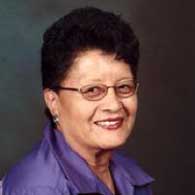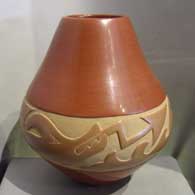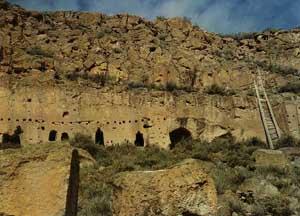
LuAnn Tafoya
Santa Clara/Pojoaque


"People want to have your pots because of how you feel when you make your pots."
LuAnn Tafoya was born into Santa Clara Pueblo, the daughter of Margaret Tafoya and granddaughter of Sarafina Tafoya, LuAnn grew up learning how to make pottery from masters of the traditional craft. She began producing pottery in her late teens and the list of awards she has earned since then is very long.
LuAnn has participated in juried competitions at the Santa Fe Indian Market, Heard Museum Guild Indian Fair & Market, Gallup Intertribal Ceremonial and the Eight Northern Pueblos Arts & Crafts Show, earning awards almost every year since 1980. In 2003 she became only the second potter ever to earn both the Blue Ribbons for Best of Pottery and Best of Show at Santa Fe Indian Market.
Like her famous mother and grandmother, LuAnn specializes in larger pieces: red, black and brown, highly polished and exquisitely carved. She is also a master of the outdoor firing process.
Everything about the building, carving and firing of a large piece is different. The clay mix needs more temper, the building of the pot takes more time as it sometimes requires that a coil be allowed to dry some before the next coil is added. Polishing is a more drawn out process, as is carving. And then comes the most dangerous part of the process: the final firing. LuAnn has mastered them all.
LuAnn also learned to make pottery in the San Juan style (San Juan/Ohkay Owingeh has a very distinctive traditional style) and has earned awards for some of those pieces, too.
LuAnn has been a featured artist in books and exhibitions like The Legacy of Generations, Fourteen Families in Pueblo Pottery and Margaret Tafoya: A Tewa Potter's Heritage & Legacy. Some of her work is on display at the Heard Museum of American Indian Art & History in Phoenix, the National Museum of Women in the Arts in Washington, DC, the Cincinnati Museum of Fine Art, and at the Poeh Museum in Pojoaque, New Mexico.
LuAnn has made almost every traditional Santa Clara and San Juan pottery form. Her favorite designs to decorate with include bear paws, the avanyu, clouds, birds, kiva steps, winds and gourds.
Some Awards Won by LuAnn
- 2004 Santa Fe Indian Market. Class. II - Pottery, Div. B - Traditional pottery, undecorated, plain polished black, red, or white, including bear paw & melon design, Best of Division;
- Cat. 901 - Jars, including wedding jars, First Place;
- Div. C - Traditional pottery, carved or incised in style of San Juan, San Ildefonso, Santa Clara, Cat. 1001 - Jars, Second Place;
- Cat. 1006 - Miscellaneous (can include vases, pitchers, ladles, canteens, boxes, plates, etc.), Second Place - 2003 Santa Fe Indian Market. Best of Show
- Class. II - Pottery, Best of Classification;
- Div. B - Traditional pottery, undecorated, plain polished black, red, or white, including bear paw or melon designs, Cat. 902 - Bowls, Third Place;
- Div. C - Traditional pottery, carved or incised in style of San Juan, San Ildefonso, Santa Clara, Best of Division;
- Cat. 1001 - Jars, First Place - 2001 Santa Fe Indian Market. Class. II - Pottery, Pottery, Div. C - Traditional pottery, carved or incised in style of San Juan, San Ildefonso, Santa Clara, Cat. 1001 - Jars, Second Place
- 2000 Santa Fe Indian Market. Class. II - Pottery, Div. B - Traditional pottery, undecorated, plain polished black, red, or white, including bear paw & melon design, Cat. 902 - Jars (over 9" tall), First Place;
- Class. II - Pottery, Div. B - Traditional pottery, undecorated, plain polished black, red, or white, including bear paw & melon design, Cat. 902 - Jars (over 7" tall), Second Place - 1998 Santa Fe Indian Market. Class. II - Pottery, Div. B - Traditional pottery, undecorated, plain polished black, red, or white, including bear paw & melon design, Cat. 902 - Jars (over 9" tall), Third Place;
- Cat. 905 - Other bowls, Third Place;
- Div. C - Traditional pottery, carved or incised, Cat. 1002 - Jars (up to 7" tall), Honorable Mention - 1997 Santa Fe Indian Market. Class. II - Pottery, Div. C - Traditional pottery, carved or incised, Cat. 1002 - Jars (over 7" tall), Third Place
- 1996 Santa Fe Indian Market. Class. II - Pottery, Div. B - Traditional pottery, undecorated, plain polished black, red, or white, including bear paw & melon design, Cat. 904, Melon bowls & jars, all other, Third Place;
- Div. C - Traditional pottery, carved or incised, Cat. 1002 - Jars (over 7" tall), Third Place;
- Cat. 1006 - Wedding vases, First Place - 1995 Santa Fe Indian Market. Mela Youngblood Memorial Award for Excellence in Santa Clara Pottery from Class. II, Div. B or D;
- Class. II - Pottery, Div. B - Traditional pottery, undecorated, Cat. 902 - Jars (over 9 inches tall), Second Place;
- Div. D - Traditional pottery, carved, Cat. 1102 - Jars (over 7 inches tall), First Place;
- Cat. 1106 - Wedding vases, Second Place - 1994 Santa Fe Indian Market. Class. II - Pottery, Div. E - Traditional pottery, painted designs on burnished black or red surface; Cat. 1206 - Plates, Second Place
- 1993 Santa Fe Indian Market. Mela Youngblood Memorial Award for Excellence in Santa Clara Pottery from Class. II, Div. B or D;
- Class. II - Pottery, Div. B - Traditional pottery, undecorated, Cat. 904 - Melon bowls and jars, all other, First Place;
- Jars (over 8" tall); Div. D - Traditional pottery, carved, Best of Division;
- Cat. 1102 - Jars (over 8" tall), Second Place - 1992 Santa Fe Indian Market. Mela Youngblood Memorial Award for Excellence in Santa Clara Pottery from Class. II, Div. B or D;
Class. II - Pottery, Div. B - Traditional pottery, undecorated, Cat. 902 - Jars (over 8" tall), First Place;
- Div. C - Traditional pottery, incised in the style of San Juan, Best of Division;
- Div. D - Traditional pottery, carved, Best of Division;
- Cat. 1102 - Jars (over 8" tall), First Place, Third Place - 1991 Santa Fe Indian Market. Mela Youngblood Memorial Award for Excellence in Santa Clara Pottery from Class. II, Div. B or D;
- Class. II - Pottery, Div. B - Traditional pottery, undecorated, Cat. 901 - Jars (to 8 inches), Second Place;
- Cat. 902 - Jars (over 8 inches), Third Place;
- Div. D - Traditional pottery, carved, Best of Division;
- Cat. 1102 - Jars (over 8 inches), First Place;
- Cat. 1105 - Wedding vases - First Place - 1990 Santa Fe Indian Market. Class. II - Pottery, Div. B - Traditional pottery, undecorated, Cat. 802 - Jars (over 8"), First Place;
- Div. C - Traditional pottery, incised (in the style of San Juan), Best of Division;
- Div. D - Traditional pottery, carved, Cat. 1002 - Jars (over 8"), First Place, Second Place - 1989 Santa Fe Indian Market. Class. II - Pottery, Div. B - Traditional pottery, undecorated, Cat. 802 - Jars (over 8" tall), Second Place;
- Cat. 805 - Other bowls, Third Place;
- Div. C - Traditional pottery, incised (in the style of San Juan), Best of Division;
- Div. D - Traditional pottery, carved, Best of Division;
- Cat. 1002 - Jars (over 8" tall), First Place - 1986 Santa Fe Indian Market. Class. II - Pottery, Div. B - Traditional pottery, undecorated, Cat. 802 - Jars (over 8" tall), Second Place;
- Cat. 804 - Other bowls, First Place;
- Div. D - Traditional pottery, carved, Cat. 1002 - Jars (over 8" tall), Third Place - 1985 Santa Fe Indian Market. Jack Hoover Memorial Award for Excellence in Santa Clara Pottery
- 1984 Santa Fe Indian Market. Class. II - Pottery, Div. B - Traditional pottery, undecorated, Cat. 801 - Jars (up to 8 inches), Second Place
- 1983 Santa Fe Indian Market. Class. II - Pottery, Div. B - Traditional, undecorated, Second Place;
- Div. D - Traditional, carved, First Place, Second Place
Photo of LuAnn Tafoya courtesy of the artist, © LuAnn Tafoya, 2006.
100 West San Francisco Street, Santa Fe, New Mexico 87501
(505) 986-1234 - www.andreafisherpottery.com - All Rights Reserved

Santa Clara Pueblo

Ruins at Puye Cliffs, Santa Clara Pueblo
Santa Clara Pueblo straddles the Rio Grande about 25 miles north of Santa Fe. Of all the pueblos, Santa Clara has the largest number of potters.
The ancestral roots of the Santa Clara people have been traced to ancient pueblos in the Mesa Verde region in southwestern Colorado. When that area began to get dry between about 1100 and 1300 CE, some of the people migrated eastward, then south into the Chama River Valley where they constructed several pueblos over the years. One was Poshuouinge, built about 3 miles south of what is now Abiquiu on the edge of the Jemez foothills above the Chama River. Eventually reaching two and three stories high, and with up to 700 rooms on the ground floor, Poshuouinge was occupied from about 1375 CE to about 1475. Drought then again forced the people to move, some of them going to the area of Puye (on the eastern slopes of the Pajarito Plateau of the Jemez Mountains) and others downstream to Ohkay Owingeh (San Juan Pueblo, along the Rio Grande). Beginning around 1580 CE, drought forced the residents of the Puye area to relocate closer to the Rio Grande and they founded what we now know as Santa Clara Pueblo on the west bank of the river, with San Juan Pueblo to the north and San Ildefonso Pueblo to the south.
In 1598 the seat of Spanish government was established at Yunque, near San Juan Pueblo. The Spanish proceeded to antagonize the Puebloans so badly that that government was moved to Santa Fe in 1610, for their own safety.
Spanish colonists brought the first missionaries to Santa Clara in 1598. Among the many things they forced on the people, those missionaries forced the construction of the first mission church around 1622. However, like the other pueblos, the Santa Clarans chafed under the weight of Spanish rule. As a result, they were in the forefront of the Pueblo Revolt of 1680. One Santa Clara resident, a mixed black and Tewa man named Domingo Naranjo, was one of the rebellion's ringleaders. However, the pueblo unity that allowed them to chase the Spanish out fell apart shortly after their success, especially after Popé died.
When Don Diego de Vargas came back to the area in 1694, he found most of the Santa Clarans on top of nearby Black Mesa (with the people of San Ildefonso). A six-month siege didn't subdue them so finally, the two sides negotiated a treaty and the people returned to their pueblos. However, successive invasions and occupations by northern Europeans took their toll on all the tribes over the next 250 years. Then the swine flu pandemic in 1918 almost wiped them out.
Today, Santa Clara Pueblo is home to as many as 2,600 people and they comprise probably the largest per capita number of artists of any North American tribe (estimates of the number of potters run as high as 1-in-4 residents).
Today's pottery from Santa Clara is typically either black or red. It is usually highly polished and designs might be deeply carved or etched ("sgraffito") into the pot's surface. The water serpent, (avanyu), is a very common traditional design motif on Santa Clara pottery. Another motif comes from the legend that a bear helped the people find water during a drought. The bear paw has appeared on much of their pottery ever since.
Santa Clara has received a lot of distinction because of the evolving artistry the potters have brought to their craft. Not only did this pueblo produce excellent black and redware, several notable innovations helped move pottery from the realm of utilitarian vessels into the domain of art. Different styles of polychrome redware emerged in the 1920s-1930s. In the early 1960s experiments with stone inlay, incising and double firing began. Modern potters have also extended the tradition with unusual shapes, slips and designs, illustrating what one Santa Clara potter said: "At Santa Clara, being non-traditional is the tradition." (This refers strictly to artistic expression; the method of creating pottery remains traditional).
Santa Clara Pueblo is home to a number of famous pottery families: Tafoya, Baca, Gutierrez, Naranjo, Suazo, Chavarria, Garcia, Vigil, and Tapia - to name a few.
100 West San Francisco Street, Santa Fe, New Mexico 87501
(505) 986-1234 - www.andreafisherpottery.com - All Rights Reserved

Margaret Tafoya Family Tree
Disclaimer: This "family tree" is a best effort on our part to determine who the potters are in this family and arrange them in a generational order. The general information available is questionable so we have tried to show each of these diagrams to living members of each family to get their input and approval, too. This diagram is subject to change should we get better info.
Note: Sarafina (Gutierrez) Tafoya was the sister of Pasqualita Tani Gutierrez.
- Sarafina Tafoya (1863-1949) & Geronimo Tafoya
- Margaret Tafoya (1904-2001) & Alcario Tafoya (d. 1995)
- Mary Ester Archuleta (1942-2010)
- Barry Archuleta
- Bryon Archuleta
- Sheila Archuleta
- Jennie Trammel (1929-2010) & Charles Franklin Trammel (d. 1967)
- Karen Trammel [Beloris, Aveado, Brevell]
- Gordon Trammel (b. 1958-)
- Virginia Ebelacker (1925-2001)
- James Ebelacker (1960-) & Cynthia Ebelacker
- Jamelyn Ebelacker
- Sarena Ebelacker
- Richard Ebelacker (1946-2010) & Yvonne Ortiz
- Jason Ebelacker
- Jerome Ebelacker & Dyan Esquibel
- Andrew Ebelacker
- Nickolas Ebelacker
- James Ebelacker (1960-) & Cynthia Ebelacker
- Lee Tafoya (1926-1996) & Betty Tafoya (Anglo)
- Linda Tafoya (Oyenque)(Sanchez) (1962-)
- Phyllis Bustos Tafoya
- Mela Youngblood (1931-1990) & Walt Youngblood
- Nancy Youngblood (1955-)
- Christopher Cutler
- Joseph Lugo
- Sergio Lugo
- Nathan Youngblood (1954-)
- Nancy Youngblood (1955-)
- Toni Roller (1935-)
- Brandon Roller
- Cliff Roller (1961-)
- Deborah Morning Star Roller
- Jeff Roller (1963-)
- Jordan Roller
- Ryan Roller
- Susan Roller Whittington (1955-)
- Charles Lewis
- Tim Roller (1959-) & Clarissa Tafoya
- William Roller
- LuAnn Tafoya (1938-) & Sostence Tapia
- Michele Tapia Browning (1960-2025)
- Daryl Duane Whitegeese (1964-) & Rosemary Hardy
- Shirley Cactus Blossom Tafoya (1947-2010)
- Meldon Tafoya
- Mary Ester Archuleta (1942-2010)
- Christina Naranjo (1891-1980) & Jose Victor Naranjo (1895-1942)
- Mary Cain (1916-2010)
- Billy Cain (1950-2005)
- Joy Cain (1947-)
- Linda Cain (1949-)
- Autumn Borts-Medlock (1967-)
- Tammy Garcia (1969-)
- Douglas Tafoya
- Marjorie Tafoya Tanin
- Teresita Naranjo (1919-1999)
- Stella Chavarria (1939-)
- Denise Chavarria (1959-)
- Joey Chavarria (1964-1987)
- Sunday Chavarria (1963-)
- Stella Chavarria (1939-)
- Cecilia Naranjo
- Sharon Naranjo Garcia (1951-)
- Judy Tafoya (1962-) & Lincoln Tafoya (1954-)
- Mida Tafoya (1931-2024)
- Sherry Tafoya (1956-)
- Phyllis Tafoya (1955-)
- Robert Tafoya
- Ethel Vigil
- Kimberly Garcia
- Mary Cain (1916-2010)
- Camilio Tafoya (1902-1995) & Agapita Silva (1904-1959)
- Joe Tafoya & Lucy Year Flower (1935-2012)
- Kelli Little Kachina (1967-2014)
- Myra Little Snow (1962-)
- Forrest Red Cloud Tafoya
- Shawn Tafoya (1968-)
- Joseph Lonewolf (1932-2014) & Katheryn Lonewolf
- Greg Lonewolf (1952-)
- Rosemary Apple Blossom Lonewolf (1954-) & Paul Speckled Rock (1952-2017)
- Adam Speckled Rock
- Susan Romero
- Grace Medicine Flower (1938-)
- Joe Tafoya & Lucy Year Flower (1935-2012)
- Dolorita Padilla (1897-1960) & Alberto Padilla (1898-)
- Tomacita Tafoya Naranjo (1884-1918) & Agapita Naranjo
- Nicolasa Naranjo (c.1910-) & Jose G. Tafoya
- Howard Naranjo & Linda Naranjo
- Nicolasa Naranjo (c.1910-) & Jose G. Tafoya
Some of the above info is drawn from Pueblo Indian Pottery, 750 Artist Biographies, by Gregory Schaaf, © 2000, Center for Indigenous Arts & Studies
Other info is derived from personal contacts with family members and through interminable searches of the Internet.
(505) 986-1234 - www.andreafisherpottery.com - All Rights Reserved


